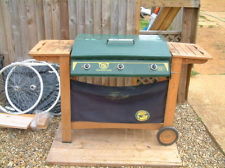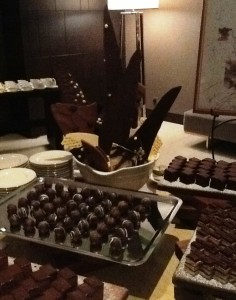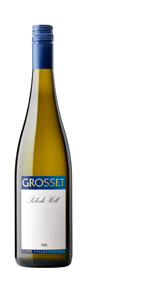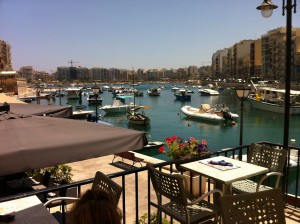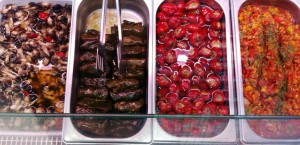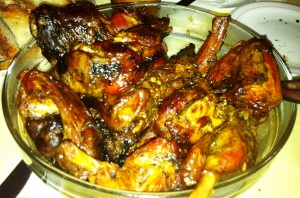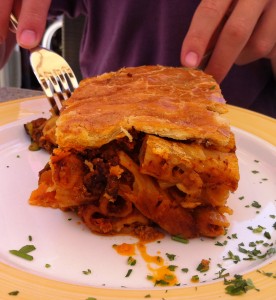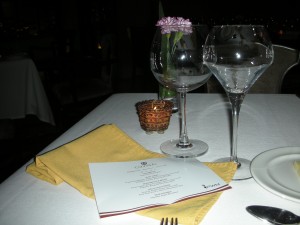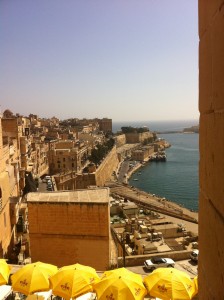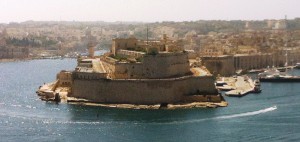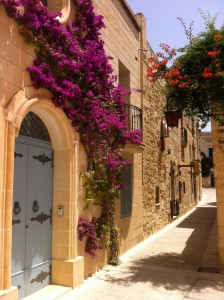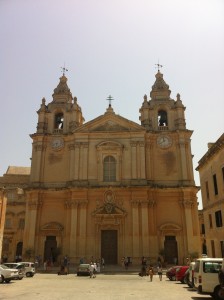 It was a dawn gathering, outside Starbucks, in Makati. Armed with coffees and cameras, we climbed aboard a minivan and headed north, past rice fields and lakes full of water hyacinths, sugar cane and wild grasses. Our tour guide, Bryan Ocampo, was full of information about Manila, and Philippine history. Obviously aiming at first time visitors to the Philippines, he soon found himself caught up in vigorous discussions with those of us who have been living here for a while.
It was a dawn gathering, outside Starbucks, in Makati. Armed with coffees and cameras, we climbed aboard a minivan and headed north, past rice fields and lakes full of water hyacinths, sugar cane and wild grasses. Our tour guide, Bryan Ocampo, was full of information about Manila, and Philippine history. Obviously aiming at first time visitors to the Philippines, he soon found himself caught up in vigorous discussions with those of us who have been living here for a while.
(I have heard it before, but I still like the phrase about the Philippines being created by 300 years in convent, and 50 years in Hollywood!)
 Our first stop was Guagua (as in water or agua), where we had an open-air breakfast in a sala beside the Lapid’s family bakery. The buffet style breakfast was a great start to the day, as so far my stomach had only seen a Starbucks coffee. I filled my plate with bite-sized longanisang guagua (local homemade pork sausages with a hint of thyme) served with an amazing, zesty green papya pickle called atchara, lechon de homo (pork belly slow cooked in an old brick oven), dried fish, rice and scrambled eggs all washed down with a mug of Tsokolate Espeysal: carabou’s milk and rich local chocolate, flavoured with crushed nuts – a kind of liquid Nutella. Although Filipinos would tend to put everything on their plates at once, we divided it up a little, keeping the suman bulagata till last. This moreish sticky rice snack was sprinkled in brown sugar for just a touch of sweetness.
Our first stop was Guagua (as in water or agua), where we had an open-air breakfast in a sala beside the Lapid’s family bakery. The buffet style breakfast was a great start to the day, as so far my stomach had only seen a Starbucks coffee. I filled my plate with bite-sized longanisang guagua (local homemade pork sausages with a hint of thyme) served with an amazing, zesty green papya pickle called atchara, lechon de homo (pork belly slow cooked in an old brick oven), dried fish, rice and scrambled eggs all washed down with a mug of Tsokolate Espeysal: carabou’s milk and rich local chocolate, flavoured with crushed nuts – a kind of liquid Nutella. Although Filipinos would tend to put everything on their plates at once, we divided it up a little, keeping the suman bulagata till last. This moreish sticky rice snack was sprinkled in brown sugar for just a touch of sweetness.
Then we set off for a short walk through the streets of Guagua, attracting a good deal of attention as the only non-Filipinos in town – and perhaps also due to my small blond niece hiding beneath her sun hat! We wandered in the sun past the street stalls of the Guagua public market, dodging jeepneys and pedicabs, dropped in on the Guagua parish church, Our Lady of the Immaculate Conception, and rode back in a pedicab. I was immensely grateful to share it with Miss Four – if it had been anyone larger we would have been squeezed in and hanging over the edges. Yet again, that humiliating reminder that I am XXXL in the Philippines.
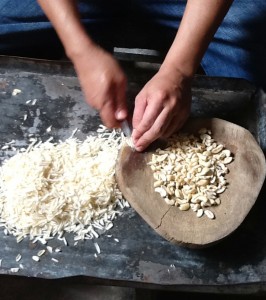 We drove on to Santa Rita, to a sweet factory, owned by the Ocampo-Lansang family. This small family business is run from the family home. “Lola” (Granny) welcomed us as we entered, with waving arms, tears and every song she could remember, delighted with her large group of visitors. We watched the sweets being made by hand, and believe me, making turrones, or cashew nut nougat, is a labour intensive business…and HOT!
We drove on to Santa Rita, to a sweet factory, owned by the Ocampo-Lansang family. This small family business is run from the family home. “Lola” (Granny) welcomed us as we entered, with waving arms, tears and every song she could remember, delighted with her large group of visitors. We watched the sweets being made by hand, and believe me, making turrones, or cashew nut nougat, is a labour intensive business…and HOT!
Chewing on turrones, we moved on to Bacalor’s famous sunken church, San Guillermo. The original church was constructed by the Augustinian friars in 1576. It was destroyed in 1880 by an earthquake, and rapidly rebuilt, only to be buried by lahare flows from Mount Pinatubo in September 1995. The ash flow claimed the altar, the cemetery and the monastery. Only the choir loft and bell tower remained. The elaborate altar, salvaged by the town’s people, now sits beneath the dome. The church itself has a barn-like quality, with its wooden roof beams six metres closer to the congregation today than they used to be. Second floor windows have been converted into new entrances, and the arches at the top of the original windows visible at waist level.
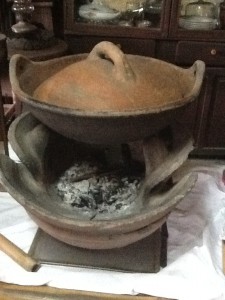 At lunchtime we drove on to Mexico, to the home of renowned Kapampangan cook and food connoisseur, Atching Lillian Borromeo. Her heritage house was built in 1916 and Borromeo has restored the original kitchen and filled it with culinary antiques.
At lunchtime we drove on to Mexico, to the home of renowned Kapampangan cook and food connoisseur, Atching Lillian Borromeo. Her heritage house was built in 1916 and Borromeo has restored the original kitchen and filled it with culinary antiques.
Atching Lillian must have been cooking for days, as there was enough food to feed the village. We lined up in orderly fashion to fill our plates. There was ensaladung pako, a salad of young fern fronds and monitor lizard eggs, sitting beside a dish of frogs, stuffed with ground pork and vegetables, and deep fried.
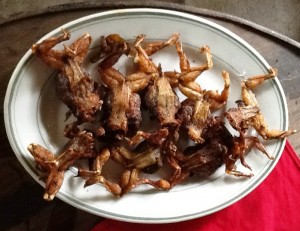
While I would try most things at least once, I have never felt overly brave when confronted with exotica like offal or insects or frogs. I have eaten frogs legs before (very tasty, like tiny chicken drumsticks), but I have never met an entire frog on my plate before. If I am honest, the only reason I finally took the plunge was to show-off to a friend, wary of anything but rice and the Golden Arches.In fact these small morsels were delicious, once I overcame the psycho-logical hang-up about munching on Kermit.
The morkon, a rich, heavy roll, mostly chicken and eggs, was delicious, but I could not manage the tidtad, a grey Pampango blood stew, which did not appeal at all, although it is apparently a local specialty. Sisig is another Pampango dish of pork cheeks, head meat and liver. I have eaten this before and it went down smoothly, despite the predominance of offal, reminding me a little of Thai larb gai, only fattier. Actually, thinking about it, a dash of lime juice would have complimented this dish perfectly. Bringhe is a filling dish of glutinous rice and chicken cooked in coconut milk – a perfect nursery food – but my undisputed favourite was a light chicken broth with squash (pumpkin) and deep green bonifacio leaves. Dessert? Tibuk-tibok, a carabao milk blancmange that slid into the very 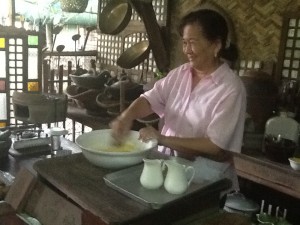 tiny space left after this enormous lunch.
tiny space left after this enormous lunch.
After lunch, Lillian gave us a history and baking lesson, displaying her carved wooden moulds from the seventeenth century and telling the tale of the origins of her Panecillos de San Nicolas or arrowroot biscuits. Several of us experimented with rolling out the dough and using the wooden moulds, and received a lovely bamboo and coconut shell stirring spoon as a reward for our efforts.
We said our goodbyes and thank yous, and headed for Angeles, and the Holy Rosary Church whose twin towers dominate the town’s skyline. The Church was constructed from 1877 to 1896 by the forced labour system imposed on Filipino peasants by the Spanish colonial government. We were lucky to get a peek today, as the church had been closed to prepare it for the annual fiesta held in honor of the Blessed Virgin of the Holy Rosary.
Opposite the church is a museum with a culinary twist, housed in the original Town Hall. Exhibits included a Culinarium – a display of culinary artifacts – and a collection of dioramas illustrating Kapampangan culinary history in intricate detail, complete with Nenita dolls that we were itching to play with. There was even a culinary library in the old jail.
 And then, finally, we pulled in for an early dinner at San Fernando’s ‘Everybody’s Café’. It was a light and tasty grand finale, just the right amount after a day full of meals and merienda. There was a bit of a free-for-all over the beef morcon, with a side dish of deliciously rich dripping, and a wonderful sinigang containing the most enormous freshwater prawns I have ever seen or tasted, huge and meaty, like lobster. And of course, the pièce de résistance: Kamaru or adobodo crickets with caramelized red onions, surprisingly sweet, and, equally surprising, my favourite dish, despite my own protestations that eating anything so tiny was simply ridiculous.
And then, finally, we pulled in for an early dinner at San Fernando’s ‘Everybody’s Café’. It was a light and tasty grand finale, just the right amount after a day full of meals and merienda. There was a bit of a free-for-all over the beef morcon, with a side dish of deliciously rich dripping, and a wonderful sinigang containing the most enormous freshwater prawns I have ever seen or tasted, huge and meaty, like lobster. And of course, the pièce de résistance: Kamaru or adobodo crickets with caramelized red onions, surprisingly sweet, and, equally surprising, my favourite dish, despite my own protestations that eating anything so tiny was simply ridiculous.
The day was so much more than just a food tour. In fact it felt like a microcosm of Filipino culture and all that the Filipinos are most passionate about: their politics, their religion and their food. Thanks for sharing that passion with us, Bryan, and we hope you enjoyed our rendition of ‘”It’s not easy being green” and “Why are there so many songs about rainbows?” on the way home, in memory of Kermie.
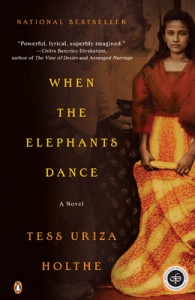 ‘When the Elephants Dance’ is a fascinating and powerful first novel from Filipino-American author Tess Uriza Holthe, inspired by the stories of her father’s experiences during the Second World War.
‘When the Elephants Dance’ is a fascinating and powerful first novel from Filipino-American author Tess Uriza Holthe, inspired by the stories of her father’s experiences during the Second World War.



